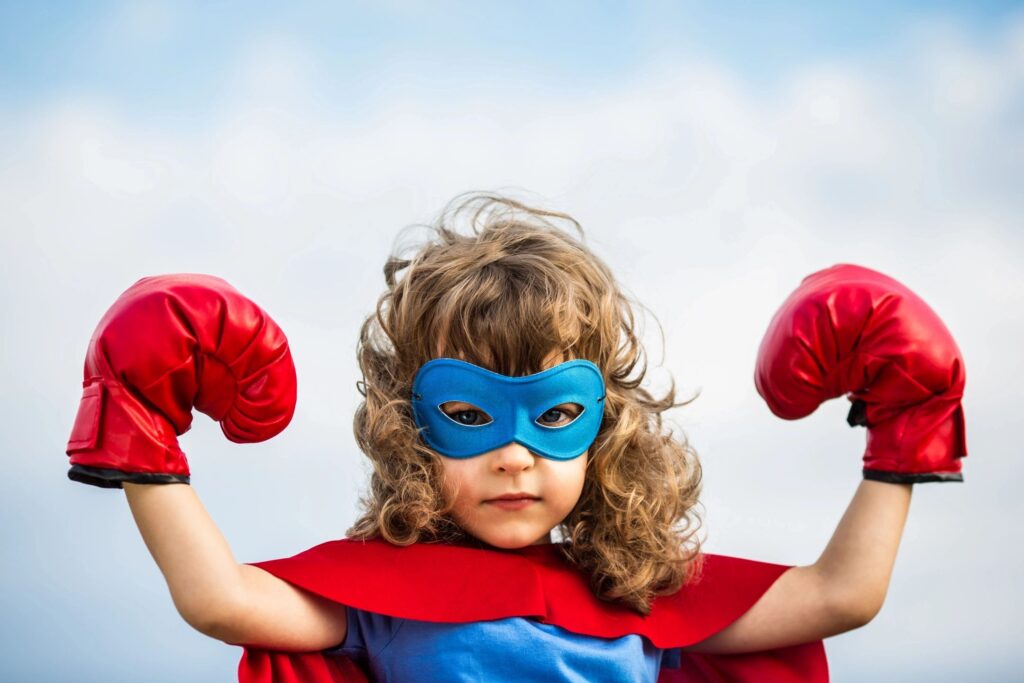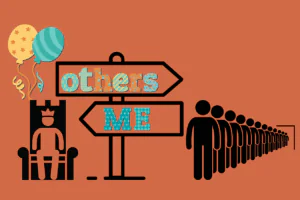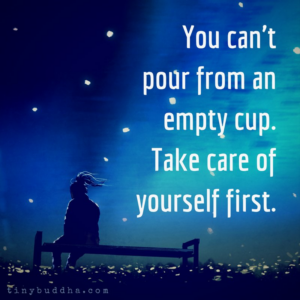Guest post by Rebecca Muir, LSW
Originally published in September, 2021
Late one night some time ago, my son was engaged with me in an epic battle to avoid going to bed. Every excuse and delay tactic he could throw my way got tossed. Eventually, he settled hard on the old “monsters” routine, and we were at a standoff. I was tired and depleted from trying to talk some reason into a five-year-old. Suddenly, I blurted out an unusual solution. “I have superpowers, and I put up a forcefield around our house. No monsters can get in. They can’t even see us.” After a few follow up questions regarding the strength and coverage of this forcefield, my son smiled and finally laid down to go sleep. Success! But you might be thinking what does this have to do with mindfulness activities for kids? Read on.
My son felt safe thanks to my “superpowers,” and I got to go to sleep. In the following weeks, however, my son started asking more questions about my powers and what I could and could not do with them. I started to feel guilty about lying to him. Enter my completely unintentional start to walking the path of mindfulness.
Why practice mindfulness?
I started my mindfulness journey more intentionally while sitting at my temp-job desk, a cubicle no bigger than an elementary school desk, while listening to Audible. I’m late to the audiobook scene. As an undergraduate English major, I maintained my love of good old-fashioned paper and ink books with entitlement. However, when faced with 40 hours a week of confinement, I caved and signed up. I had no idea what I had been missing!
I absorbed a lot about mindfulness from self-development books. Here are some I have listened to:
- Happy is the New Healthy by David Romanelli
- The Practicing Mind by Thomas M. Sterner
- The Craving Mind by Judson Brewer
- Healthy as F*ck by Oonagh Duncan
- Untamed by Glennon Doyle
- The Five Keys to Mindful Communication by Susan Gills Chapman
- The Mindful Day by Laurie J. Cameron
- Peace is Every Step by Thich Nhat Hanh
Mindfulness is touched on in all these wonderful works, and I have had some seriously amazing success applying mindfulness practices from these works to my own life. You can learn tips for mindfulness activities for kids from these books, too!
Back to my superpowers. I now believe I started to develop a real superpower, and that is mindfulness. I saw the opportunity to change my fib to my son into something wonderful. After a few weeks of intentionally applying mindfulness practices in my life, my son and I bonded and connected on a new, deeper level. When we spend time together, I live together with my son in that moment, and I observe just how much he loves being around me and doing things together. Talk about a gift of mindfulness!
I asked my son if he would like to start Superpower Training with me in the morning before I leave for work. He was all for it. After a quick YouTube search for Mindfulness Meditations for kids, I was happy to find a whole range of options. For the past two months we have spent a little time (anywhere from 4 to 8 minutes) sitting, breathing, and meditating together. My son initially had a hard time sitting still, but I made a point to begin and end our time together sitting up straight and taking deep breaths. He has slowly been getting better at it, and so have I!
Making Superpower Training part of the morning routine keeps me accountable to my meditation practice every day, adds precious quality time with my son to my day, and sets both of us up for a successful day from the start. I am amazed and grateful for just how big of an impact that living mindfully has already had in my life. I am excited to see how things will continue to change!
Children’s Mindfulness Programs
Have I enticed you? Here are some tips to practice Mindfulness activities for kids (or that you can modify to do mindfulness for students if you’re a teacher):
- Start your day with a quick meditation or mindfulness practice – As I mentioned, YouTube is a great resource for children’s mindfulness programs. Try them out with your child(ren) to find the ones you like best.
- Take time to express appreciation for the small things – Children take cues from their parents. The more I point out how pretty the moon is or how wonderful the flowers smell or how neat the cloud look, the more my son does it, as well.
- Have meaningful conversations away from screens – My son learned about recycling at school and how pollution is bad for the Earth. I asked him what he thought we could do to help the Earth. He came up with the idea to pick up trash. So we go for a walk to our park once a week and pick up trash along the way. We must be mindful to see the trash. He feels good about doing something truly meaningful, and once again we get to spend quality time away in nature.
- Start a gratitude ritual – We love to sit and draw together at my house. So, I decided to draw a gratitude tree from scratch. There are many resources online for templates if you Google search for them. Every night, my son and I each pick two or three things we were grateful for that day and either write it down or draw a picture of that thing on our tree. Discussing or drawing about what we’re grateful for brings that gratitude more into the realm of mindfulness. It also sets a pattern for mindfully seeing and experiencing those things for which we’re grateful.
- Naming emotions – When my son is overwhelmed by big emotions, we have an emotions chart on our fridge that he can go to and point to indicate what he is feeling in that moment. We then have a conversation about the feeling, and I ask him what he would like to do about it. Maybe he needs a few minutes? Maybe we should take some deep breaths together? The point is helping him notice his feelings and learning to dialogue about them. The more he becomes aware of his feelings, the better we communicate and solve problems together. Again, this is helping him develop a mindful pattern to support his emotional growth. An emotions chart is another tool that can be found online via Google search.
Try one new mindfulness activity for kids at a time and see the results for yourself. My son and I have never been closer. He is more self-aware and expresses appreciation more frequently. When there are melt-downs, they are shorter and easier to resolve. Most importantly, he is learning a life skill to help him stay grounded, to find confidence in being heard and validated, and to help him cope with the curveballs that life will throw his way.
Rebecca uses several therapy approaches with clients. These include CBT (Cognitive Behavioral Therapy), Strengths-Based/Solution-Focused Therapy, and Talk Therapy. She loves incorporating mindfulness-based strategies during therapy and encourage clients to use them outside of sessions to help create a more peaceful, joy-filled life. Rebecca sees clients in the Glen Ellyn office.





